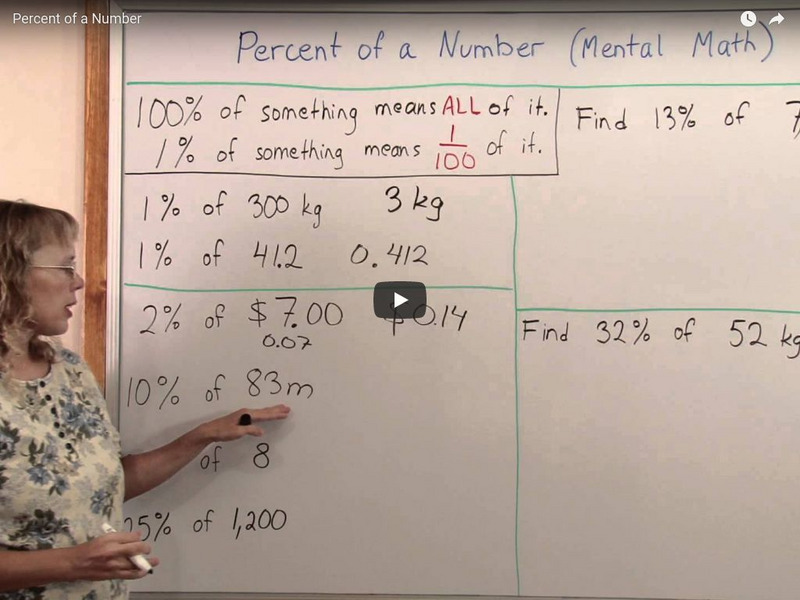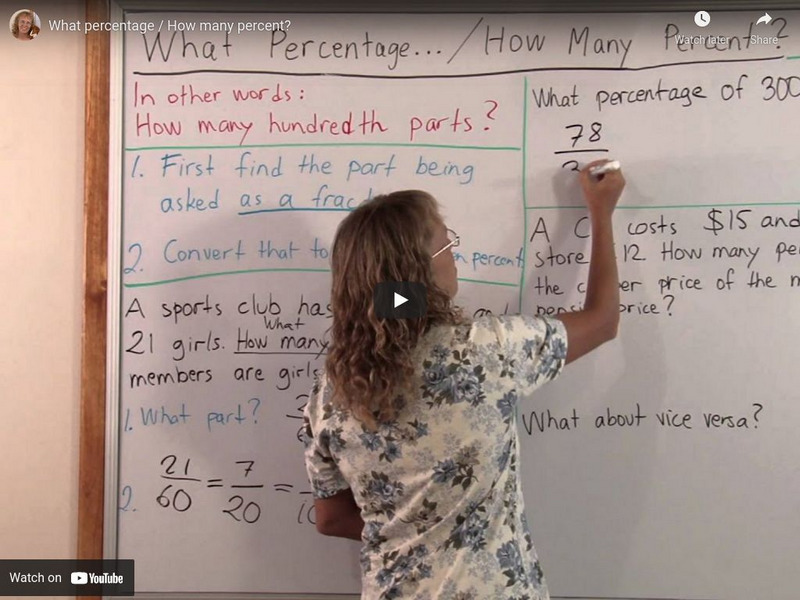Hi, what do you want to do?
PBS
The Lowdown — The Math of Trash: Percents and Proportions
Don't toss the lesson in the trash. Scholars watch an informative, up-to-date video that discusses how percents and proportions help clarify data about trash, recycling, and climate change. They consider their own trash output and create...
PBS
The Lowdown — Defining and Calculating Percents
Don't discount the lesson. Part of The Lowdown: Real-World Math series, an engaging video shows viewers how to calculate percent discounts using the idea that percents are ratios out of 100. It also looks at how to determine whether a 20...
PBS
The Lowdown — Percents Defined
Out of every 100 times, how many times was the lesson a success? Scholars first watch a short video from The Lowdown: Real-World Math series to learn about the meaning of percents. They then color in 10-by-10 grids to express percents...
PBS
Recognize and Represent Proportional Relationships between Quantities: Ratio, Proportion, Cross Multiply, and Divide
Review three video clips for one major concept. The resource contains three short clips to introduce the idea of ratios and proportions and how to solve a proportion. After watching the video, partners use their noses to push pom poms...
Anywhere Math
Percent Proportion
You'll be 100 percent satisfied with a helpful math video. Scholars watch an engaging YouTube video to learn how to solve percent problems (finding the part, finding the whole, and finding the percent). The method employed here is to set...
Anywhere Math
The Percent Equation
Watch the whole video, not just part of it. An instructive video shows how to solve percent problems using equations. It describes finding the whole, given the part and the percent; finding the part, given the percent and the whole; and...
Math Antics
Finding a Percent of a Number
Use the knowledge of multiplying fractions to find a percent of a number. The video builds the process to find the percent of a number by recalling that the word of in fraction problems meant to multiply. Finding the percent of a...
Math Antics
Percents Missing Total
Is there a formula to help find the total in a percent problem? Given the part and the percent, the resource shows how to find the total. The video provides a two-step formula to find the total and goes through two word problems to...
Math Antics
What Are Percentages?
Get the most out of 100. A video presents percents as special fractions with 100 as the denominator. The narrator breaks down the term percent into its root and prefix. Using learners' knowledge of converting fractions to decimals,...
Math Antics
What Percent Is It?
Which of the three percent questions is being asked? There are three basic types of percent problems, the resource covers the type when the percent is unknown. The resource shows two methods of finding the percent, either through the use...
Math Antics
Percents and Equivalent Fractions
Why convert fractions into percents? The video reminds viewers that percents are a fraction with a denominator of 100. Using equivalent fractions, the resource shows how to change percents to a fraction without a denominator of 100. The...
Scholastic
Study Jams! Identify Outcomes and Make Predictions
Making predictions and identifying possible outcomes are skills that all science pupils should possess. In this video, Mia and Sam discuss the chances of puppies being male or female as an example. The animation is adorable, and will...
Virtual Nerd
How Do You Use an Equation to Find a Part of a Whole?
Watch the instructor change a percent into a decimal and multiply it by the original number to determine the percent. One idea would be to embed this video in a PowerPoint presentation, or assign it as homework with your flipped...
Virtual Nerd
How Do You Use a Proportion to Find a Part of a Whole?
There are two methods for finding the percentage of a number. One is to use an equation, and the other is to use a proportion. This tutorial demonstrates with clear examples how to implement the proportion method. Insert this video into...
Khan Academy
Khan Academy: Arithmetic and Pre Algebra: Growing by a Percentage
This video shows how to calculate the total amount after a number has grown by a certain percentage. Practice problems are available. [9:43]
Khan Academy
Khan Academy: Arithmetic and Pre Algebra: Solving Percent Problems 3
This video demonstrates how to find the base number when given a percentage and amount. Practice problems are included. [5:26]
Khan Academy
Khan Academy: Arithmetic and Pre Algebra: Identifying Percent Amount and Base
This video shows how to identify the percent amount and base in a word problem. Practice problems are available. [2:32]
Khan Academy
Khan Academy: Arithmetic and Pre Algebra: Solving Percent Problems
This video demonstrates how to find the base number when given a percentage and amount. Practice problems are available. [6:17]
Math TV
Math tv.com: Basic Mathematics: Basic Percent Problems
A math teacher and several students guide you through solving a collection of basic problems involving percents. Watch videos for step-by-step solutions to questions, such as, "What number is 15% of 63?" and "25 is 40% of what number?"...
Math TV
Math tv.com: Basic Mathematics: Basic Percent Problems: Applications
A teacher and several math students offer step-by-step solutions to word problems involving percents. Examples include, "How much HCl is in a 60-milliliter bottle that is marked 80% HCl?" and "Suppose the purchase price of a stereo...
Math Mammoth
Math Mammoth: Percent of a Number
See how you can use mental math to find the percent of a number by first determining 1% or 10% of the number. [7:04]
Math Mammoth
Math Mammoth: What Percentage / How Many Percent?
See how to think through problems asking for the percent by first thinking about fractional parts. [6:10]
Math Mammoth
Math Mammoth: How to Solve Basic Percent Word Problems, Part 2
This video demonstrates how to find a percentage of an area by beginning with fractional parts. [4:55]
Math Mammoth
Math Mammoth: How to Calculate the Percent of Change (Increase or Decrease)
A beginning lesson that demonstrates how to find the percentage of change, whether an increase or decrease. [9:47]




























